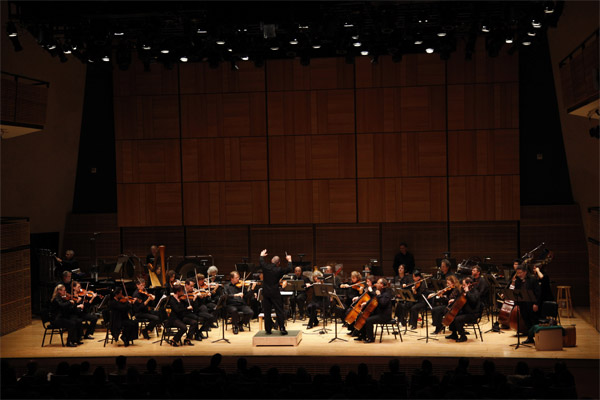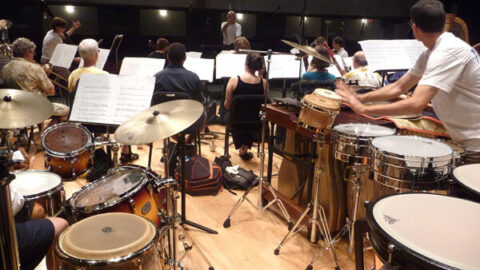 Any concert of recently composed orchestra music by young composers, as the American Composers Orchestra presented Saturday at the Winter Garden of the World Financial Center as part of SONiC Festival, is guaranteed to provide a clear impression of how young composers are thinking about the orchestra. It is also perhaps doomed to provide a similarly clear impression of how young composers are thinking about the orchestra. That high-wire act lends an excitement, a danger, to new music concerts that standard-rep love-fests just don’t have, and can’t have.
Any concert of recently composed orchestra music by young composers, as the American Composers Orchestra presented Saturday at the Winter Garden of the World Financial Center as part of SONiC Festival, is guaranteed to provide a clear impression of how young composers are thinking about the orchestra. It is also perhaps doomed to provide a similarly clear impression of how young composers are thinking about the orchestra. That high-wire act lends an excitement, a danger, to new music concerts that standard-rep love-fests just don’t have, and can’t have.

Cálmate, relax, I’m not about to write a negative review of any of the pieces on the program. The pieces were all composed with the highest level of musical integrity, orchestrated with great skill and sensitivity, and performed with riveting intensity and dedication by the ACO, conducted with mesmerizing precision and expressiveness by music director George Manahan. However. There’s the fact that half the pieces on the program had a stratospherically high violin solo surrounded by soft sustained strings, which made me pay less attention to the music and more to the fact that here was another obligatory high violin solo. More important, though, is the enormous pressure inflicted on young composers writing orchestral music. This pressure is coming at them (us) from all sides: the orchestra itself, with its insane union rules on recordings, gaunt rehearsal schedules, and religiously specific rules regarding notation and even paper size; the press and the audience, who seem to simultaneously and sincerely hope that new pieces will succeed (good new music!) and fail (I look smart criticizing it!); and the composers them/ourselves, who convince them/ourselves not inaccurately that they/we may never ever have this opportunity ever again, and that a huge orchestral success can be a career-maker, and so they/we MUST GET EVERYTHING PERFECTLY RIGHT THIS TIME.
This pressure manifests itself in a bunch of different ways musically, but the most obvious one to my ears is really a general young composer problem, and not unique to orchestra music. It’s the Too Many Ideas problem. It’s not a major problem, since there’s nothing inherently bad with having an overwhelming amount of content in your music, or with musical ideas that are very short. I’ve seen tons of great pieces where the high density of ideas was the point (as it was in Andrew Norman’s Unstuck, on this program), and tons of horrible pieces by young composers who wished they were Sigur Rós. What is a problem is when one concert features many pieces at one extreme, and few pieces at the other or in between. It’s the same problem I encountered with ICE’s program at The Kitchen last Thursday, just with different musical parameters. This was my only big problem with the ACO’s concert at the Winter Garden––I was way up front, so I didn’t experience the muddy acoustics that I know happen in the Winter Garden if you’re, well, anywhere except way up front. Of the six pieces on the program, four were what any reasonable person would call “high idea density” pieces, and the remaining two were “low idea density” pieces. Again, this is not any kind of value judgment.

Paul Yeon Lee’s Echo of a Dream was definitely on the high-density team, but that made it a great choice for an opener, and since it was the opener, I only thought of it as a high-density piece in retrospect. The dream hinted at in the title seemed to be a nightmare, with driving, angular rhythms and dissonant chords set against tense, wandering chromatic lines. One particularly effective moment towards the end of the piece brought many disparate layers of sound together, suddenly and shockingly congealing into a throbbing, unison surge of rhythm.
Ruby Fulton’s Road Ranger Cowboy made for a great follow-up, described by the composer as being a portrait of an out-of-place self-styled cowboy driving through (relatively cowboy-free) Iowa. An easygoing country tune was filled with Ivesian irregular and jarring gaps in the groove, not unlike a car CD player skipping after driving over a pothole. The quirky finale, an ambient soundscape over which a solo violin and viola traded bow-crunched moos––seriously––was a priceless moment of humor, made even better by several members of ACO’s string section working very hard (and unsuccessfully) to keep from laughing. This was a short character piece, roughly half the length of Echo of a Dream, and definitely one of the two low-density pieces.
The next three pieces were on the high-density team, and the brevity of Road Ranger Cowboy meant that by the time we got to Bryce Dessner’s blessedly low-density closer St. Carolyn by the Sea, I was pretty desperate for a musical idea that lasted longer than three seconds before something else interrupted it, which would then itself only last for three seconds. That isn’t a knock on the pieces in between Fulton’s and Dessner’s, but I do feel that programming them all together did them a disservice. It certainly caused me to enjoy them less than I would have had the program been more balanced. I’m sure I’d have had the same reaction had the imbalance been the other way around (hurry up and let’s go already!).
Ryan Gallagher’s Grindhouse (the title refers to exploitation films) pushed density, particularly rhythmic density, to its limits. A stuttering alternation of two dissonant chords, shoved through a gauntlet of shifting meters and accents, was the strongest and most memorable gesture, and overall the music’s character transcended the abrasive harmony to hint at a kind of dangerous exuberance. Suzanne Farrin’s Infinite Here, also a shorter work, created a tense conflict––between gorgeous ambience in color and volume, surges of dark harmony, and the constantly shifting orchestration––to great expressive effect. I only wish the piece were longer; at three and a half minutes, it was over almost as soon as it had begun. In Unstuck, by Andrew Norman, the lack of both cohesiveness and coherence was the whole point, not a bug but a feature. Sections of music abruptly disappeared and then reappeared seemingly at random, usually interrupting something else in the rudest possible manner. I have never suffered from ADHD, but I imagine that it must feel something like Unstuck, and I mean that as a compliment.

From one extreme to the other, it’s interesting that the evening’s most cohesive and coherent work was by Bryce Dessner, whom most of us know through his rock work in The National and Clogs. He is also, of course, a Yale-trained classical guitarist, and his piece, St. Carolyn by the Sea, had an impressively tight focus, clear trajectory, and mature pacing. Dessner was joined on a pair of electric guitars for the performance by his twin brother and National co-member Aaron Dessner, and their seating between violins and basses reflected the guitars’ function, not as soloists but as a section within the orchestra. Building patiently from a single held note to a churning climax evocative of a relentless coastal storm, St. Carolyn by the Sea at its beginning could have been just another postminimal rock-inflected orchestra piece, though its uncommon harmonic and timbral beauty (those guitars!) and rhythmic inventiveness quickly put that fear to rest. It ended up being a powerful, and unexpectedly moving, portrayal of our rocky, contradictory relationship with the sea: our wonder at all it is, our gratitude for all it can give, and our fear and our grief at all it can take away.
—
Jeremy Howard Beck is a New York-based composer, as well as an active trombonist. Follow him on Twitter: @jeremyhowardboo
























